What are the best pinky batteries? Which batteries are better? What types of batteries are there?
Introduction
Despite the widest distribution of batteries of various types, conventional disposable batteries have not yet disappeared from the market. Moreover, many people also use them to power devices that consume sufficiently large currents - sometimes forcedly (for example, being away from the outlet where they could charge a set of batteries), sometimes only because manufacturers of inexpensive cameras and wireless mice They still come with batteries...
In our article today, we will try not only to compare different batteries with each other, but also to find out how suitable they are for various applications.
Testing methodology
Although there are many medications to treat hypertension, and people can also adjust their diets and exercise more, doctors recommend a blood pressure monitor for home use to help people at risk manage their conditions. Home monitoring should be carried out along with occasional monitoring by a doctor. Its daily use can help a person monitor their blood pressure and alert them to get to the hospital before they have a stroke or heart attack.
You can't physically feel when your blood pressure is too high - it's a condition that only shows up when tested. Thus, continuous monitoring is key for patients at increased risk. This includes diabetics, those with hypertension and certain heart conditions, and pregnant women who are at risk of preeclampsia.
The methodology according to which we conduct testing can be found at the link: "". Since it includes not only a description of the test setup, but also explanations regarding the different types of batteries and the features of their operation, it is recommended that you read it before reading this article.
Below, for each of the batteries, we will give a photograph and graphs of the discharge curves (the dependence of the battery voltage on time at a given load). Since there are many of these graphs, and they are of only limited interest and for a narrow circle of readers, we will simply put links to them without overloading the article with pictures. In a more visual form, the test results are presented at the end of the article.
If you are interested in comparing bit characteristics, it will be more convenient to download a PDF file (1 MB), where they are collected in one large table.
Salt batteries
Camelion
Despite the inscription "Super Heavy Duty", we have ordinary low-capacity salt batteries. The marketing designation "Heavy Duty" at one time appeared to separate two types of salt batteries - but the "weak" type has not been produced for a long time, and the name has remained.
Batteries behaved rather unusually when discharged with a current of 750 mA: at a certain moment, the voltage on them began to grow, although the load current was maintained constant. This is possible due to the heating of the batteries (as the temperature increases, the rate of chemical reactions in them also increases), however, in in this case this is unlikely - firstly, in our test setup, the batteries are blown by a fan during discharge, and secondly, the same type of batteries from other manufacturers, including those tested simultaneously with Camelion, did not demonstrate such an effect. So, probably, the reason for this was some peculiarities of the chemistry of Camelion batteries.
However, the discharge curve shows that salt batteries are still of little use for powering high-current devices: at a current of 750 mA they run out almost instantly.
GP Greencell
Gold Peak Group (GP) products are very common in retail sales - it is difficult to find a store selling batteries that does not have GP batteries. The Greencell series are very inexpensive salt batteries.

Some "quantified self-esteem" fanatics view blood pressure as an indicator of overall health, although they do so out of general curiosity rather than following any established medical guidelines. We took 10 blood pressure monitors to the University of Texas School of Nursing to test and find the most accurate, comfortable, and easy-to-use model.
There are four various types basic blood pressure monitors available for home use: upper arm monitors that automatically inflate with the touch of a button, upper arm monitors that require the user to pump bladder to inflate them manually, controls that blood pressure measurement at the wrist and monitors for the fingers.
Discharge curves of GP Greencell batteries are given at the following links:
GP Supercell

Although the "Super" prefix makes it seem like these batteries should outperform GP Greencell, the reality is a little surprising: Supercell showed the worst result among salt batteries, noticeably behind Greencell.
Panasonic Special Power
Panasonic batteries are one of the few salt (zinc-carbon) batteries for which this is indicated directly on the label: as a rule, manufacturers indicate the type only on alkaline batteries.

The most important element of a blood pressure monitor is its accuracy. Bruce Alpert, former co-chairman of the Association for the Advancement of Medical Sphygmomanometer Instrumentation Accuracy in wrist and finger monitors can be compromised by the type of algorithm the manufacturer uses to compensate for reading further from your heart. This is determined by the blood pressure machine itself and the size of the cuff.
The conditions under which you measure your blood pressure—from time of day to body position—are also independent of the machine, according to Dr. Lee Goldstein at the University of Texas School of Nursing. Student nurses at the University of Texas School of Nursing took their own blood pressure and noted their observations of the use of each monitor.
It is difficult to say what the “special power” of Panasonic salt batteries is - according to the test results, they do not stand out among their competitors in any way.
Sony New Ultra
Well, okay, the historically established “Heavy Duty”, but still typed in huge letters “New Ultra” is, in our opinion, an overly pretentious name for ordinary salt batteries.
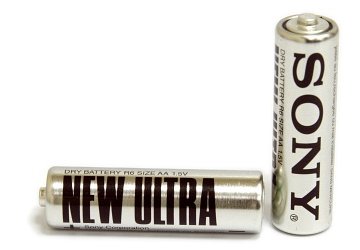
Moreover, according to the test results, they do not stand out among their competitors at all.
Varta Superlife
But the Varta company outwitted itself with the names: Longlife batteries are saline, Lognlife Extra are alkaline, and Superlife are salt again.
![]()
Our experts recommend that the monitor should not deviate more than 10 mmHg from your doctor's pressure. Keep in mind that none of the monitors we tested could be calibrated after this fact, so check accreditation websites carefully and be sure to keep your receipt. To achieve the best accuracy at home, you must pay close attention to the testing method and the fit of the cuff that wraps around your arm. If the cuff is the wrong size, your reading will be off.
According to Goldstein and Alpert, using a blood pressure cuff that is too small can result in a patient's systolic blood pressure being higher. Many blood pressure monitors come with various sizes cuffs, so choose one that matches your arm circumference.
Discharge curves are presented at the following links:
Alkaline batteries
"Auchan"
These nameless “Alkaline batteries” (a separate minus to the brand owners for their mocking attitude towards the Russian language) are sold in stores of the Auchan retail chain. The real manufacturer is unknown; the address of Auchan itself is indicated on the packaging. In addition, the batteries have an unusually short shelf life - only two years (usually it is five to seven years).

According to Goldstein and Alpert, using a blood pressure cuff that is too small can cause a patient's systolic blood pressure to be considered higher. Once you are confident that you have an accurate monitor that fits, the second component to getting an accurate result is paying close attention to the test-taking process. Goldstein recommends reading your blood pressure in the morning before getting out of bed for the day. Sit upright with your back and both feet flat on the floor.
Ideally, the cuff should be placed on the arm for five minutes without moving or talking before doing the reading. In addition to accuracy, features to look for in a quality upper arm model include memory for storing blood pressure readings so you can compare trends over time and abnormal pulse detection. This is a useful feature because while an irregular heartbeat may not mean anything significant, it can be a sign that your heart is struggling to pump enough blood.
Camelion Oxy-Alkaline
The name of these Camelion batteries brings to mind the Oxyride batteries developed by Panasonic and designed for use in high power consumption devices. They differ from alkaline ones not only in name, but also in composition: they use nickel oxide-hydroxide NiOOH.

We don't know if the names are coincidental, but we can't help but notice that the discharge characteristics differ from typical alkaline batteries: the initial voltage of Oxy-Alkaline exceeds 1.6 V, an absolute record among the batteries we tested.
Duracell
"Semi-nameless" (they do not have any proper name, only the name of the manufacturer) Duracell batteries are intended for devices with low to medium power consumption.

While this in itself may not be anything alarming, if it is consistent, you would want to talk to your doctor. Having multiple cuff sizes to choose from is a bonus. In general, there are three price levels for these machines. Some may suggest that heart rate detection is incorrect, but this is incorrect across the board.
Which batteries are better?
When deciding which models to test, we followed the recommendations of the American Heart Association and looked for monitors that had been tested by the Association for the Advancement of Medical Instrumentation, the British Society of Hypertension, or the International Protocol for the Testing of Automated Blood Pressure Monitors.
Battery discharge curves are given at the following links:
Duracell Turbo
But Duracell Turbo batteries are designed for a more serious load: the battery packaging cites cameras, players and the pink “Duracell hare” as examples of such. Duracell's range also includes batteries with even higher power, but they have not yet been included in our tests.

Indeed, Duracell Turbo drives very confidently, the difference is especially noticeable at heavy loads.
Energizer
In terms of the number of battery models presented in our article today, only GP can compete with Energizer - four each. Their market segments overlap only partially, with GP occupying the lower to mid-range and Energizer occupying the mid-to-upper market.
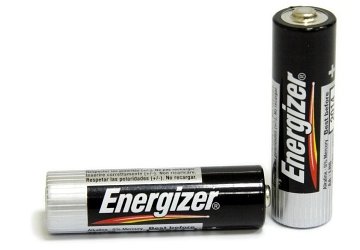
We were looking for cuffs that were comfortable and easy to put on. All of the models we tested had a cuff that went over the upper arm, but some had a stiffer ring that the patient could insert into the arm and then tighten the fastener; they were easier to manipulate.
Some monitors offer large displays that are easy to read without flawless vision. Some show basic systolic and diastolic pressure data and nothing else on the display, while other models include a pulse and even an averaging function that will automatically take blood pressure three times in a row and average them together for a more accurate reading. Others will let you manually take your blood pressure three times over a 10-minute period and then average them together.
However, the first battery that does not have own name, is the youngest in the Energizer line.
Energizer Maximum
But Energizer Maximum batteries belong to a newer and more technically advanced series. They are designed to power devices with high power consumption.

Battery discharge curves are given at the following links:
Energizer Ultra+
Although it is problematic to determine which is better - Ultra + or Maximum - by name, subjective preferences are more likely on the side of Maximum. New design, shiny mirror wrap...
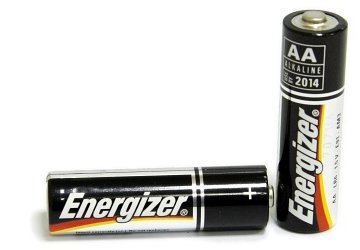
This helps those who may be nervous the first time they take their blood pressure. The student nurses tested all nine monitors, comparing their baseline blood pressure measured by professional equipment to that of the device being tested.
Conclusions on batteries
Each participant began with a blood pressure reading from laboratory equipment taken by two professors, each registered nurse. Each person then tested all nine monitors, comparing their baseline blood pressure to the test unit. Because recompression of blood vessels in the arm during multiple trials will affect the accuracy of subsequent readings, we only considered the first two readings of each cuff when determining accuracy, generally looking at cuffs that read within 10 mmHg. pressure suggested by doctors.
Interestingly, according to the test results, neither Ultra + nor Maximum can be given the first place: in one test they caught up, in another, Maximum was ahead, and in the third - Ultra +.
GP Super Alkaline
If the previous two GP batteries were saline, then the type of the next two is clear already by their name - alkaline.
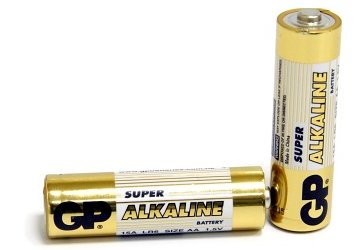
Battery discharge curves are given at the following links:
GP Ultra Alkaline
And once again we freeze in front of the store shelf: which is better, “Super” or “Ultra”?.. Eh, it wouldn’t be easy to just indicate the capacity or some other unambiguous numerical parameter, like with batteries. Perhaps the indication on the packaging (at least on one of its variants) of Ultra Alkaline that it is suitable for powering digital equipment may give a hint.
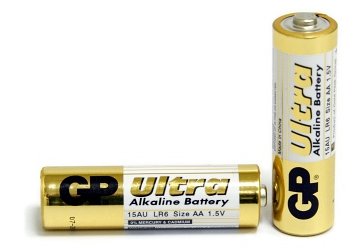
All participants took the tests while supporting their back. Each participant also had the opportunity to record their impressions of each monitor and cuff after the reading. They considered the comfort of the cuff, ease of putting it on and reading the display, and any other factors they considered important. Many of these areas are subjective, and some, like reading speed, will vary from person to person, but we looked for commonality in their contributions. At the end of the group testing, we continued with further tests on the five models that were most closely tested with student nurses.
However, testing dots the i’s: “Ultra” is better than “Super”! At least for GP.
IKEA Alkaline
As you might guess, these batteries are sold in IKEA stores. They say that previously you could find the Varta emblem on them, but on our samples the true manufacturer was not indicated, so we can only guess about the origin of the batteries.

Fortunately, IKEA batteries are sold pre-assembled.
Kodak Max
We don't know if Kodak recommends using only these batteries in their cameras, but we think that many other companies are missing out on their chance to get some exposure by not following Kodak's lead and releasing batteries under their own name.
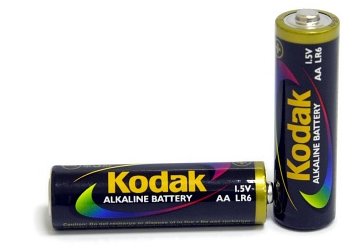
Those two testers that measured out of range were still within 15 mmHg. pressure measured with professional equipment. Another said the cuff "hurts the shoulder for larger people." Luckily, the cuff is a larger size than the one we tested. The cuff has a dot and a diagram that tells you how to line up the cuff with your artery running along the inside of your arm, which is a common feature among test takers.
Extensive testing of AA and AAA batteries
In our tests, blood pressure was quiet and quite fast, although each person will experience different times based on the size of their hands and their blood pressure. It can store readings for two users, and it has an easy-to-use switch on the face of the monitor to switch between each person's results. It can detect irregular heart rates and automatically enters the user's blood pressure three times in a row and averages them together to produce the most accurate results.
Moreover, according to the test results, Kodak Max, although they did not become a leader, made it into the top ten without any problems.
Samsung Pleomax
Under the Pleomax brand, Samsung sells several groups of products at once - from simple computer peripherals to light bulbs and batteries. In our opinion, the use of one brand, which is also still little known to customers, somewhat depersonalizes specific products, but the company’s marketers know better.
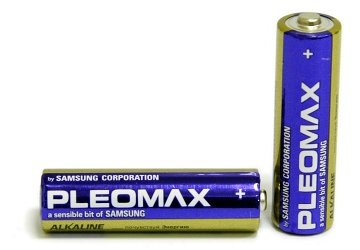
Battery discharge curves are given at the following links:
Sony Stamina Plus
There are no problems with determining which of the names of Sony batteries corresponds to their greater power and capacity: the front side of the package tells us that Stamina Plus will give us an additional 10% of energy (as to what exactly is indicated elsewhere and in much smaller print), and the back side - that if this is not enough, then there is also Stamina Platinum.
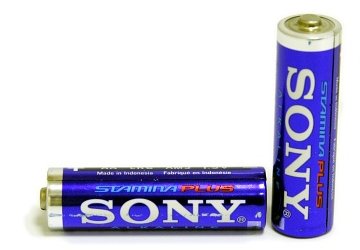
Other models will allow you to do this manually, but we find it much more convenient if you don't have to do it. You don't need to configure the app to get results. You can store up to 200 results on the device at a time, which means 100 blood pressure readings per person. You take the monitor and cuff from the box, install the batteries, close the battery compartment, and then connect the cuff tube to the jack on the monitor to get started. Sending data to the app is an easier way to chart your blood pressure over an extended period of time and turns that data into easy-to-understand trend graphs.
Battery discharge curves are given at the following links:
Sony Stamina Platinum
So, as the manufacturer assures us, these batteries should significantly outperform the previous model...
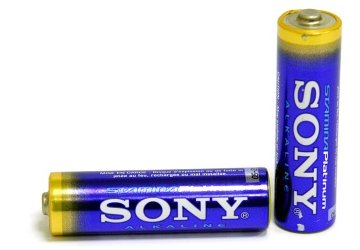
Interestingly, this is confirmed only at high currents - while at relatively low currents Stamina Plus comes out a little ahead. Reminds me of the situation with Energizer Ultra+ and Maximum, doesn’t it?
TDK Power Alkaline
If we complained above that it is difficult to compare products from the same manufacturer by name, then what can we say about different manufacturers. Well, which is better – Power Alkaline or Ultra Alkaline? Or is it the same thing? Gentlemen, introduce some general methodology and write ampere hours on your batteries that are understandable to ordinary people!
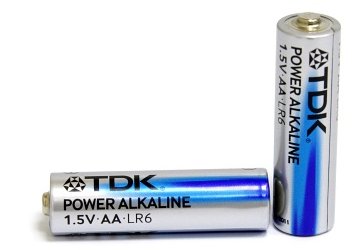
If you decide not to use the app, a quick glance at the well-laid out manual will help you set up your monitor in no time. You want to set the time and date, which is as simple as pressing a button and moving two additional buttons printed with up and down arrows on the device.
Once you accept the pairing from your phone, there is a small action in the app and suddenly your data will be transferred. The app shows your readings on a graph, a much more user-friendly and useful user experience than scrolling individually through 100 previous readings on the monitor itself. It also shows your pulse in a huge, easy-to-read type and lets you know if that pulse is unreal. Those with high blood pressure will not only see numbers telling them their systolic pressure is above 140 mmHg;
According to the results of our tests, TDK Power Alkaline ended up in the middle group.
Varta High Energy
For administrative and technical reasons, low-power alkaline Varta batteries (for example, Longlife Extra) were not included in our article today - unlike high-power batteries designed to power equipment with high energy consumption.

And indeed, in two out of three tests Varta High Energy took first place in the rating.
Varta Max Tech
Varta Max Tech batteries are positioned as batteries for equipment with very high consumption. But what exactly does this mean? Larger capacity?
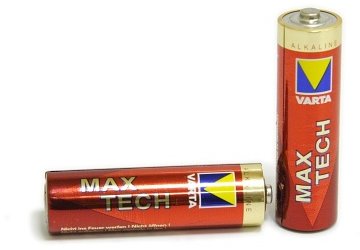
As measurements have shown, not quite: when discharging with low and medium currents, Max Tech loses to the High Energy series, but when discharging with very high currents, on the contrary, they win. This means one thing: with a capacity comparable to High Energy, Max Tech has less internal resistance.
Space
Our article ends with products from a domestic manufacturer—more precisely, products sold under a domestic brand. Alas, his relationship with his native language is complex and ambiguous, as clearly evidenced by the inscription “Alkaline battery”.

Discharge curves of Cosmos batteries can be viewed at the following links:
Space Maximum
The large inscription “Alkaline” even more clearly demonstrates the ambiguity of the relationship between the Cosmos company and the Russian language. It’s not very clear, except why it says “0% mercury” below and not “0% mercury” - well, just to maintain the general style of a mixture of English and Nizhny Novgorod.
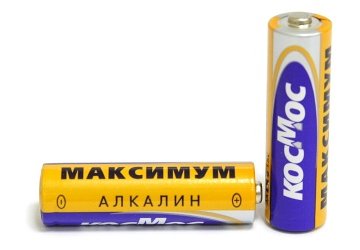
It is also interesting that the Cosmos Maximum batteries were unable to demonstrate any tangible superiority over the Cosmos batteries - in two tests they were almost equal, and in the third Maximum they lagged far behind.
Launch of Super Alkaline
If products sold under the Cosmos brand are produced at the facilities of Eastpower International, then Start batteries are produced by the already familiar Gold Peak Group.

Judging by the measurement results, the words “Super Alkaline” in the name are not accidental - there is a noticeable difference between Start Super Alkaline and GP Super Alkaline in only one test out of three.
Lithium batteries
Lithium batteries with an operating voltage of 1.5 V (in other words, interchangeable with alkaline and salt batteries) are quite rare, and therefore only one model of them is presented in our article...
Energizer Ultimate Lithium
The manufacturer specifies a capacity of 3 Ah for these batteries. The rated capacity of most alkaline batteries is also 3 A*h, but there is one caveat: for alkaline batteries it is measured when discharged with a current of only 25 mA and, as we saw above, as the discharge current increases, the capacity quickly drops. For lithium batteries, the effective capacity is almost independent of the discharge current.

And indeed, even with a load current of 750 mA, when all the alkaline batteries without exception “sank” considerably, the measured lithium capacity remained equal to 3 A*h! This battery withstood the most severe pulse load mode with honor, the current amplitude in which reaches 2.5 A - more than four hours of operation, while only a few alkaline batteries lasted at least one hour.
We decided not to test at a current of 250 mA for obvious reasons - after such success at high currents it simply does not make sense.
Summary of results
Above, we presented discharge graphs for each of the tested batteries - the dependence of the voltage on the battery on time at a given load. However, it is difficult to compare batteries by them, so for the sake of greater clarity, we calculated its capacity for each battery and summarized the results in several diagrams.
However, before moving on to the numbers, it’s worth talking about the capacity itself. Traditionally, it is indicated in ampere-hours: a capacity of 1 A*h means that the battery can deliver a current of 1 A for an hour. Generally speaking, this definition of capacity is incorrect - after all, capacity is the amount of energy stored in a battery, energy is measured in joules, which, in turn, are converted into “electrical” units using the formula 1 J = 1 W*s. Accordingly, the battery capacity should be measured in watt-seconds (or, more conveniently, in watt-hours), and not at all in ampere-hours.
Let us illustrate this with a simple example. Let's say we took two batteries with a voltage of 1.5 V and a nominal capacity of 1 A*h and connected them in series. We received a battery with a capacity of the same 1 A*h - if it is loaded with a current of 1 A, it will run out in 1 hour, because during this hour each of the batteries will deliver a current of 1 A. But in fact, the capacity of such a battery is twice as much than each individual battery. Therefore, it is more correct to take into account the capacity in watt-hours. In the example above, for one battery it will be equal to 1.5 Wh, for two - 3 Wh, regardless of the method of connecting them (series or parallel).
It is especially important to take this into account when comparing batteries and accumulators with different operating voltages: for example, a lithium-ion battery with a rated capacity of 1 A*h and an operating voltage of 7.4 V stores much more energy than a Ni-MH battery with a rated capacity of 2 .7 A*h and a voltage of 1.2 V – 7.4 Wh vs. 3.24 Wh.
For batteries with the same nameplate voltage, indicating the capacity in watt-hours makes sense if you consider that when discharged, the voltage across them drops differently. Let's say, if two batteries at a current of 1 A ran out in an hour, but the first one was kept at a voltage of about 1.2 V almost the entire time, and the second one quickly dropped to 0.9 V - it is obvious that the first one gave off more energy.
However, if you relate to real loads, then they may have different energy consumption patterns: as a rule, simple devices(flashlights, electromechanical children's toys, and so on) consume more current, the higher the battery voltage, but electronic devices(cameras, players, and so on) tend to consume constant power - that is, the higher the supply voltage, the less current they require, and the easier the operating mode of the battery in them. Therefore, for the latter, the capacity in watt-hours is of greatest importance.
In addition, it is important to determine what we consider the end of the discharge. In our articles for batteries, we will take two points: a drop in battery voltage to 0.9 V and to 0.7 V. The first was chosen for the reason that many devices may simply refuse to operate at a lower voltage, so the battery in them will “sag” below 0.9 V, it can be safely considered discharged. However, there are also devices that can operate at voltages up to 0.7 V - these are various electronics that use step-up pulse converters to obtain the power they need. There is no point in continuing testing when the voltage drops below 0.7 V - the vast majority of batteries are already completely discharged when this limit is reached, and then the voltage on them drops to zero almost instantly. Therefore, as the second point we choose the moment when the battery is discharged to 0.7 V.
Also, to make it easier for our readers to navigate the numbers, we present a plate with the results of energy consumption measurements various devices from previous article:

So, for each battery in each test, four values will be presented: capacity in ampere-hours and in watt-hours for discharge up to 0.9 V and up to 0.7 V. The results are sorted by values for discharge up to 0.9 V, as according to the most stringent of the criteria.
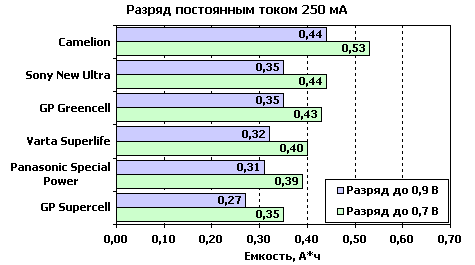
Among low-current salt batteries, Camelion products won; GP Supercell batteries were the outsiders, demonstrating a significant lag behind the Greencell series of the same manufacturer. At the same time, in general, all the batteries showed a very modest result, only one was able to reach 0.5 A*h, and even then - with a deep discharge of up to 0.7 V.
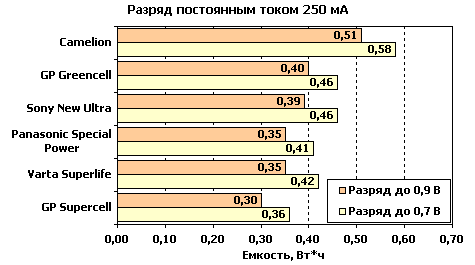
When converted to watt-hours, the picture does not change. IN middle group two pairs of batteries swapped places, but the gap between them and in the previous test was at the level of the measurement error.
![]()
At a current of 750 mA, the result is extremely sad: up to the 0.9 V limit, all batteries “sank” almost instantly. For this reason, using salt batteries in a flashlight, camera and similar equipment is completely pointless: at best, their operating time is calculated in minutes, at worst, the device will not turn on at all.
When discharged to 0.7 V, the Camelion battery came out ahead - we have already discussed above its strange behavior when discharging with high currents. However, this will not change the weather; the result is still extremely modest.

When switching to measuring capacity in watt-hours, the positions in the rating are saved.

But alkaline batteries, when discharged with a small current, show completely different values! Moreover, for them, the difference between the capacities measured by a voltage drop of up to 0.9 V and up to 0.7 V is quite small - which means that the battery effectively gives up most of the energy accumulated in it before its voltage seriously "sags".

Varta High Energy batteries are in the lead, closely followed by Sony, Cosmos and others. The worst looking batteries are IKEA Alkaline and GP Super Alkaline (including those sold under the Start brand). Two points are interesting in this graph: firstly, “high-power” batteries such as Energizer Maximum, Sony Stamina Platinum and Varta Max Tech not only did not take the first positions, but also lost to less powerful models from the same manufacturers. Secondly, Camelion Oxy-Alkaline batteries, which took the last position in the rating in terms of capacity in ampere-hours, when converted to watt-hours, noticeably moved towards the middle - this is due to their high operating voltage. However, they still cannot compete with Varta High Energy.

When discharging with a current of 750 mA, the leader remained the same - Varta High Energy - but the “high-power” batteries noticeably moved up to the top of the list, while some of the “low-power” batteries, on the contrary, fell sharply down. Let's say Energizer Maximum and Ultra+, Sony Stamina Platinum and Stamina Plus, essentially changed places.
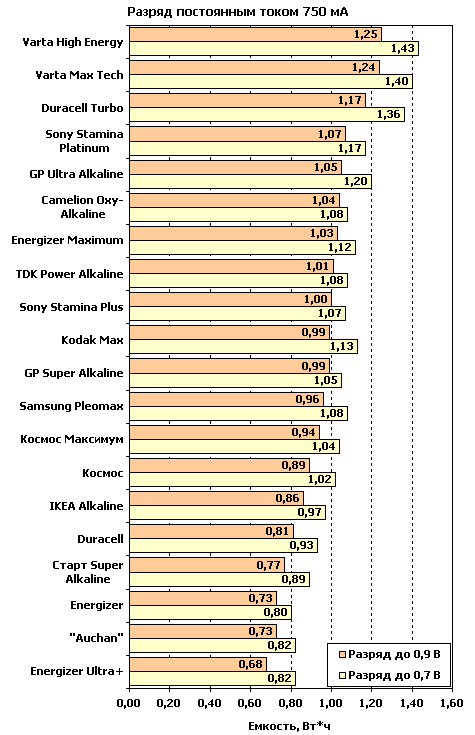
When moving to watt-hours, the order generally remains the same, with the exception that Camelion Oxy-Alkaline batteries, due to their high operating voltage, again jump up the rankings. In general, it can be noted with some sadness that the capacity of all batteries dropped significantly with increasing load current: none of the participants even reached one and a half watt-hours.
From comparing the diagrams for different loads, it becomes obvious that there are no unambiguously best batteries: different types are truly adapted for different tasks. Let's say, for an LED flashlight that consumes 100 mA, there is no point in overpaying for expensive batteries with maximum power - this is power, not capacity, so in a device that consumes a small current, they do not last any longer than their cheaper counterparts.

A pulse discharge with a current amplitude of 2.5 A is the most severe of our tests, but it is in this that the advantages of “high-tech” powerful batteries are manifested. Varta Max Tech comes out on top, followed by Camelion Oxy-Alkaline, Sony Stamina Platinum and Energizer Maximum - that is, models originally intended for devices with very high power consumption.
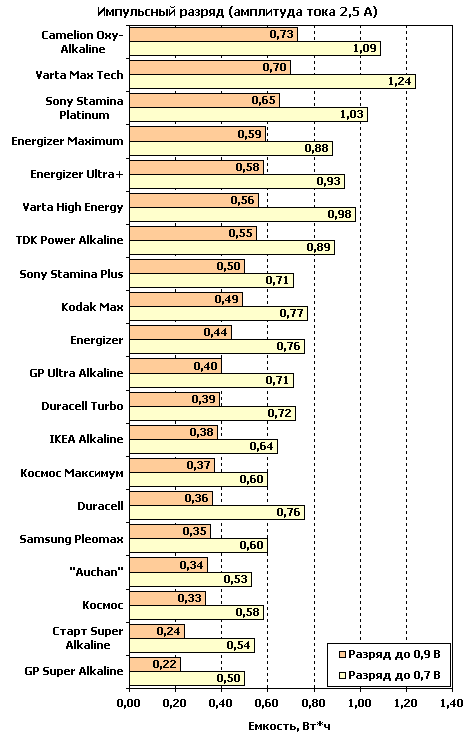
When moving to watt hours, Camelion Oxy-Alkaline becomes the leader - due to its high operating voltage. The rest of the picture does not change.
In general, it should be noted that a pulse load with an amplitude of 2.5 A is a very difficult task even for alkaline batteries.
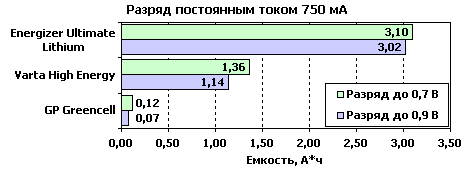
And finally, lithium batteries. Since only Energizer Ultimate Lithium is present in our article among representatives of this type of galvanic cells, we will compare it with the leaders among alkaline and salt batteries - this will allow us to evaluate what lithium batteries are capable of and whether they are worth the money.

However, from these two diagrams everything is already obvious: at a current of 750 mA, lithium batteries are many times superior to alkaline ones, while the results of salt batteries can be ignored altogether. Moreover, when moving to watt-hours, the gap only widens - a lithium battery holds voltage better as it discharges.

In the pulse discharge test with a current amplitude of 2.5 A, salt batteries fail immediately: the very first pulse drops the voltage on them to almost zero.

The lithium battery not only maintains its position, but also further increases the gap from the alkaline one: when converted to watt-hours, the difference reaches five times! And this, mind you, is compared not with the abstract “ordinary battery”, but with the leader of our previous tests.
And finally, the last table: the internal resistance of the batteries. It was calculated by the voltage drop in the test with a pulsed load; for the calculation, we took a section of the graph in which the voltage dropped to 1.0 V with the arrival of a pulse. For example, if upon the arrival of the next pulse the voltage dropped from 1.32 to 1.0 V, then the resistance is (1.32V - 1.0V)/2.5A = 0.128 Ohm.
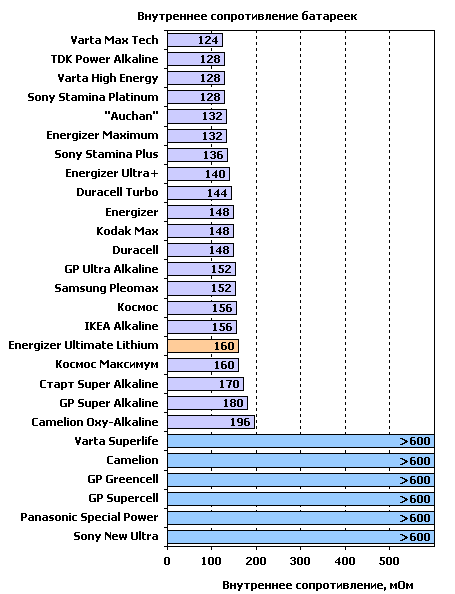
Powerful batteries, led by Varta Max Tech, are at the top of the rating. Camelion Oxy-Alkaline took last place among alkaline ones, but we have repeatedly noted above that a relatively high operating voltage helps it take first place in actual capacity. It also helped the lithium Energizer Ultimate Lithium, whose internal resistance also turned out to be relatively high.
Otherwise, the greatest resistance, as expected, was found in GP, IKEA and Cosmos batteries - outsiders in our testing. And, of course, all salt batteries showed a very high internal resistance - as noted above, the pulse discharge test is excessively cruel for them.
Instead of a conclusion: batteries versus accumulator
From the data obtained, many interesting conclusions can be drawn, the main ones of which can be conveniently collected in a compact list:
salt batteries are fundamentally unsuitable for devices with high consumption;
different alkaline batteries are optimal in terms of capacity and price ratio for different applications: powerful and expensive batteries will not provide greater capacity when discharging with low currents than their cheaper counterparts, but they will benefit when discharging with very high currents;
The capacity of both salt and alkaline batteries strongly depends on the discharge current: the higher it is, the lower the capacity;
The capacity of lithium batteries is almost independent of the discharge current, so at high currents they provide many times more capacity than the best alkaline ones.
However, another question arises - how well do batteries compete with rechargeable batteries? It is especially important in the light that the cost of lithium batteries is approaching the cost of good Ni-MH batteries with a capacity of 2700 mAh.
We will talk about the operation of batteries with light loads in the next article, but now I will allow myself to show three diagrams with the same time axis scale, which show the operation of different batteries with our pulsed load:

Alkaline battery
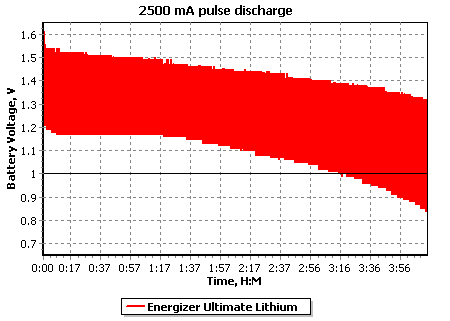
Lithium battery
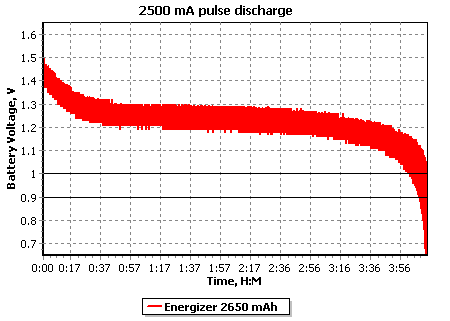
Ni-MH battery
The disadvantage of the alkaline battery is obvious, but there is parity between the lithium battery and the battery - on the one hand, the lithium battery has a slightly larger capacity and higher operating voltage, on the other hand, the width of the line clearly shows that the internal resistance of the battery is three times less.
The conclusion from this can be made simple: alkaline batteries, when operating at high currents, are in principle unable to achieve the characteristics of modern Ni-MH batteries. Lithium batteries are generally capable of competing with batteries, but do not demonstrate pronounced superiority - therefore, their use is justified in cases where batteries are not available. If timely charging of a set of Ni-MH batteries is not a problem for you, then they will the best way power supply of any devices with high power consumption - flashlights, cameras, players, toys...
We will talk about which batteries to choose in our next article.
Other materials on this topic
Methodology for testing batteries and accumulators
Every time I bought batteries, I wondered: which ones are better. There are many batteries at approximately the same price, there are cheap batteries sold only in certain stores - Ikea, FlexPower, Okay, there are expensive Duracell, Energizer batteries. Are expensive batteries always better than cheap ones?
I've been wanting to compare batteries for a long time, and finally I did it.
The iMAX B6 was used for testing. Each battery was discharged with a current of 0.2A until it could produce such a current. To confirm the results, I tested two copies of some batteries. My experiments took almost two months, because testing each battery took about ten hours. All results are in the table.

Measured battery capacity in milliamp-hours. The voltage was measured on the battery two minutes after the start of the test. After the battery “died”, it was left for some time (usually half an hour) and the test was carried out again, while it gave out some more energy - “Capacity 2”. The cost per amp hour is shown in the last column.
The results look more clear in the diagram
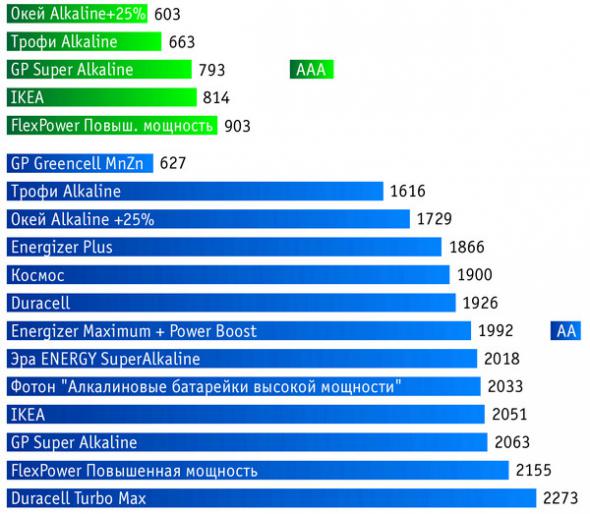
A table sorted by cost per amp hour shows which batteries are the best value.
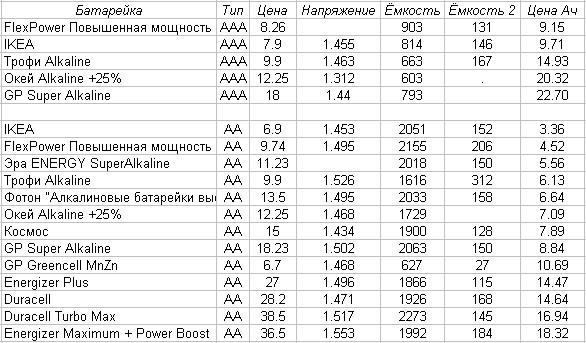
1. There is no point in buying regular Duracell and Energizer batteries. They are nothing better than batteries, which are 2-4 times cheaper.
2. Duracell Turbo Max for 38 rubles apiece, of course good batteries, but not as much as they ask for.
3. The capacity of salt batteries is three times less than that of the cheapest alkaline (alkaline) ones.
4. Trophy, Okay - not very good batteries.
5. Duracell is better than Energizer. :)
6. GP, Photon, Era, Cosmos - good batteries, the difference in capacity is less than 10%.
7. The most profitable batteries are Ikea and FlexPower, but they are sold only in Ikea and F-center stores, respectively.
8. The capacity of AAA batteries is almost three times less than AA.
9. It is possible that under certain conditions (for example, when discharging with high currents), expensive Duracell batteries may be more efficient than when discharging with medium current, but it is unlikely that their capacity will be as high, for example, Ikea, as their price is higher (5.5 times) .



